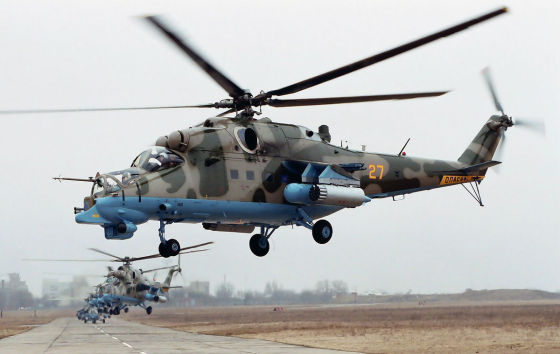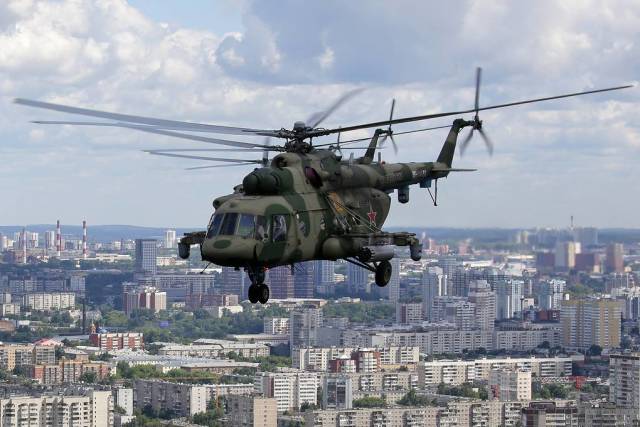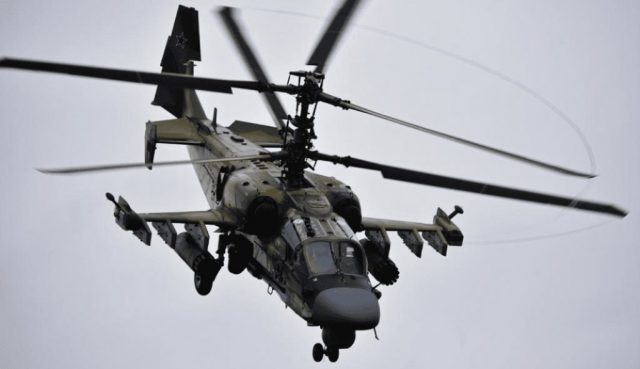We are talking about new technologies in the domestic helicopter industry
The aviation industry today strives not only to create new airplanes and helicopters, but also to control the condition of already flying machines, to know in advance about emerging problems and not to repair, but not to allow breakdowns. Such an approach can solve many problems, including in the issue of national security — maintaining combat readiness of military aircraft and helicopters already supplied to the troops. Designers have long thought about developing such a system that could monitor the condition of aircraft and signal emerging problems.
The first such system in Russia was created and has already begun to be implemented by specialists of the Scientific and Innovation Center "Institute for Research, Development and Technology Transfer" (SIC "IRT"). The Ka-52M helicopter became a pioneer who received this unique condition monitoring system.
TASS spoke with Vladimir Kargopoltsev, scientific director of the IRT Research Center, and Nikolai Lvov, CEO of the company, about the capabilities of the aviation monitoring system, the prospects for its use on military and civilian aircraft and helicopters, as well as why the integrated monitoring system "will open a new era in the operation of aviation equipment and its development."
The human body is a unique intellectual system permeated with nerve endings, receptors, and thousands of kilometers of blood vessels. If something starts to fail, the receptors send signals about the failures and problems that have occurred. This makes it possible to react in time and successfully "repair" our body without leading to critical situations. A similar monitoring system for aircraft is being created today by aviation industry specialists.
Engineers in the 70s of the last century talked about the development of a diagnostic system for the condition of an airplane or helicopter, but then there were not sufficient technical solutions in their arsenal.
The opportunity today to create miniature sensors of various physical nature, use new materials and durable fiber has allowed us to develop and begin to implement a system for continuous monitoring of the condition of aircraft / helicopter structures, which, like vessels and receptors in the human body, permeates vital systems and machine assemblies.
"Crystal"
In Russia, the program to create an integrated monitoring system for aircraft and helicopters based on domestic solutions using sensors of various physical properties began in 2015, when SIC IRT and the Foundation for Advanced Research (FPI) launched the research work "Crystal". Institutes of the Russian Academy of Sciences, the Central Aerohydrodynamic Institute named after Professor N.E. Zhukovsky (TsAGI) and other organizations participated in it as co-executors.
The work was successfully completed in 2017 and showed that it is fundamentally possible to determine the location of the impact energy and the occurrence of cracks with three small sensors on a meter-by-meter section of composite material in the absence of external visible damage to the composite panel.
As the scientific director of the Scientific Research Center "IRT" told TASS Vladimir Kargopoltsev, currently the problem of implementing a system for monitoring the condition of structures is particularly acute. This is due to the large-scale introduction of new materials (in particular, composite materials into various structural elements of aircraft, including power composite structures), the introduction of new production technologies, and the ever-expanding areas of operation of aircraft for which there is no significant experience in their application.
As the scientist noted, the most problematic issue of composite materials is the issue related to their impact resistance and the occurrence of internal cracks. "If a lot of experience was accumulated on old materials, special theories were developed on the development of cracks, metal resistance, then this experience was absent on composites. It wasn't just our problem. This is a problem that the whole world has been working on and is working on," admitted Vladimir Kargopoltsev.
According to him, despite the obvious solutions to create a sensor-based monitoring system, the developers faced certain difficulties. "It would seem that everything is clear — implement sensors, take readings, but there were many problems: sensors must be highly reliable, accurate, miniature. Their introduction into the design should not lead to a loss of regularity of the design environment. They should also be small so as not to be a source of disturbances when loading the structure. In addition, in order to capture all the features of the aircraft's condition, the sensors must have different physical nature — sensors of acoustic emission, deformation, temperature, corrosion and others," said the scientific director of the Scientific Research Center "IRT".
Russian specialists managed to successfully complete the work and create a system that shows the "health" of the aircraft and predicts possible failures. The sensors of the system continuously monitor the condition of significant structural elements of the machine during flight, including from the onset of defects to the development and appearance of cracks and possible structural integrity violations.
"With this system, we understand not only the condition of the machine, we can understand the entire history of the problem. We can predict the remaining life of the aircraft and the onset of a pre—failure condition," Kargopoltsev said.
The scientist noted that the next step is the further development of the system using a new generation of sensors with advanced capabilities, increasing the coverage of controlled elements of aircraft, their assemblies and systems. "It is especially important and a priority to create and implement a new generation of software products with wide application possibilities, including for analyzing large amounts of collected information," Vladimir Kargopoltsev noted.
Nikolai Lvov
the head of the company LLC SIC "IRT"
He clarified that the information received today from the Ka-52M includes data on the operability of the main structural elements of the helicopter and, in general, on its condition, including the residual life and resources of individual elements. "The system monitors the condition of the key elements of the helicopter structure and their interaction, which allows you to determine the "health" of the helicopter as a whole and its individual units and show their remaining life, assess the helicopter's readiness to fly," said Lvov.
 |
| The Mi-24PN transport and combat helicopter. |
| Source: http://www.russianhelicopters.aero/ |
All information about the helicopter's condition is collected and stored on an electronic onboard storage device. According to the regulations, the technician takes readings after landing the car: the information is stored on a special laptop, where, among other things, the appropriate software is installed — an "Electronic passport".
According to the developers, users should have no problems interpreting the results obtained: a detailed and simple menu is displayed where an aviation technician can select any board (helicopter), view its condition as a whole, as well as the condition of individual units. Thus, the menu displays the condition of controlled structures and units in different colors: green (everything is fine), yellow (additional inspection of the structure is required), red (critical situation). The exceeding of permissible values is also highlighted, at what stage of the flight they were obtained, because of what, when and why they led to the fact that the helicopter cannot be flown and certain work needs to be done with it.
According to Nikolai Lvov, during the adaptation of the system for Ka-52 helicopters, the developers of the IRT Research Center worked closely with the M.L. Mil and N.I. Kamov National Helicopter Center (NCB) in order to determine a reasonable number of points for installing sensors that provide information about the condition of the entire machine. "Information is collected from a reasonable number of points that we have identified together with the design bureau. More than one day, more than one year was devoted to the development of the instrument and technical part, the choice of sensor locations, the development of algorithms for processing information received during the flight to determine the "health" of the structure," said the CEO of the company.
He also talked about the new possibilities that open up when installing a machine condition monitoring system. Thus, the information obtained during the operation of the Ka-52M with this system showed a strong influence of the technical condition of the helicopter on the effectiveness of the use of weapons.
At the limit of possibilities
The implementation of the monitoring system once again clearly showed how much the piloting of a helicopter in combat differs from the use of a machine in peacetime and even from what was originally laid down during the design.
"When performing various special tasks by a helicopter and with fast-flowing (instantaneous) impacts on the structure, these differences are significant, which requires a correct assessment of their impact on the resource consumption of a single element and the apparatus as a whole. The results obtained with the help of the monitoring system, after additional analysis, can be used to improve the requirements for the device and serve as a documentary objective basis for improving the design methods of new aircraft and helicopters," Kargopoltsev said.
He also noted that during combat operations, sometimes it becomes necessary to use a helicopter or aircraft at the limit of its capabilities. This is dangerous due to the occurrence of "rapidly ongoing catastrophic processes", which the pilot must be warned about in a timely manner. "Using information from the monitoring system in a large number of cases, such advanced information can be obtained and, if necessary, displayed on the pilot's dashboard for decision—making," the scientist noted.
Flying at extreme conditions is often the key to success, but it is also a great risk for the pilot and the aircraft. As a rule, it is at close to the limit modes that a rapid resource consumption takes place, which brings the device closer to a critical state. The monitoring system can warn you about this in a timely manner.
A revolution in maintenance
Real-time monitoring of the condition of machines is expected to completely change the idea of aircraft maintenance regulations. Now cars have everything as people once had during the annual medical examination - once a year planes and helicopters are sent for maintenance. But these uniform standards do not take into account how helicopters and airplanes were operated during the year: they performed combat missions or routine flights.
Vladimir Kargopoltsev
Scientific director of the Scientific Research Center "IRT"
Collecting information about the technical condition of aircraft will allow you to know in advance that after some time it will be necessary to change certain components and assemblies, order them in advance and reduce the time and cost of machine maintenance. "Here we are moving from standardized maintenance to condition-based maintenance. This is a completely new era in the operation of aviation technology and its development," the scientist noted.
The most important thing is that constant monitoring of vital elements of aircraft will allow you to maintain the level of combat readiness of combat vehicles at a very high level. According to Nikolay Lvov, the specialists of the Scientific Research Center "IRT", together with the National Research Center "Miles and Kamov" and the Russian Ministry of Defense, plan to change the maintenance regulations for equipment equipped with a condition monitoring system.
From drones to warships
According to the creators of the monitoring system, the goal set by the company's team was not just to give the result "in vitro", but to develop a solution convenient for the aviation industry. To do this, we worked closely with design bureaus, which regularly gave feedback to developers. Together, the experts determined where it is better to place the system elements in order to take accurate readings.
According to the CEO of SIC IRT, the system is now in the first generation of its development and is being installed on Ka-52M helicopters. Moreover, it is planned to implement this system on all already built machines of this series.
Nikolay Lvov also noted that the functionality of the system can be expanded. The basis of the updated monitoring system for the Ka-52M has already been designed. "In the future, we will assess the condition of more types of helicopter units and systems in order to determine their condition and operate them according to their actual condition. Without changing the block, we will add sensors and update the software," the agency interlocutor said.
In addition, the system will help solve such a key moment for helicopter pilots as the control of alignment and take-off weight. Compliance with the alignment rules is one of the key problems of aircraft operation, which strongly affects piloting.
 |
| The Mi-8MTV-5-1 military transport helicopter, based on which the Mi-8MTV-5M was created. |
| Source: © Donat Sorokin/TASS |
"We have already tested the ability to control the alignment and take-off weight on the Mi-8. Additional sensors were installed on the landing gear struts on the helicopter, while the on-board unit itself did not change. The system will determine and provide personnel with data on flight weight and cargo alignment," said Lvov.
At the same time, it is planned to scale the monitoring system to other aircraft. The Ka-52M became the first machine, and it is also planned to equip Mi-8 and Mi-26 helicopters with the system. "Now we are preparing certification flights on civilian Mi-17s in order to certify the system on this machine and equip civilian helicopters with it," the head of the company noted.
He also clarified that the monitoring system was developed as a universal one, that is, suitable for all types of equipment. The leadership of the industry and the military department supports the initiative to implement it on all aircraft and helicopters, as well as to broadcast this solution to the space industry and shipbuilding. Based on local roadmaps that are prepared with each design bureau: NCB "Miles and Kamov", "Sukhoi", "MiG", "Ilyushin" and others, as well as with key industry institutions, are forming an "Industry map for the creation and implementation of monitoring systems."
So, the condition of the composite wing on the domestic MS-21 airliner will be monitored in real time. "We have signed a roadmap and a plan, and a technical specification for the implementation of the system on the MS-21 is being developed," said the head of the SIC IRT company.
Ilyushin is also interested in the system, and Il-76 and Il-476 aircraft may receive it. "The company is most interested in integrating the system into the Il-76 aircraft at the first stage," said Lvov.
The monitoring system can also be installed on unmanned aerial vehicles. The developers plan to offer a system for installation on land, space technology and other complex engineering systems.
To date, the aircraft condition monitoring system is on the crest of world technical achievements. And, according to the developers, its capabilities have not yet been fully realized: new sensors are being developed, software is being finalized, the system acquires new functions, helping in the operation of complex and expensive equipment.
Milena Sineva

